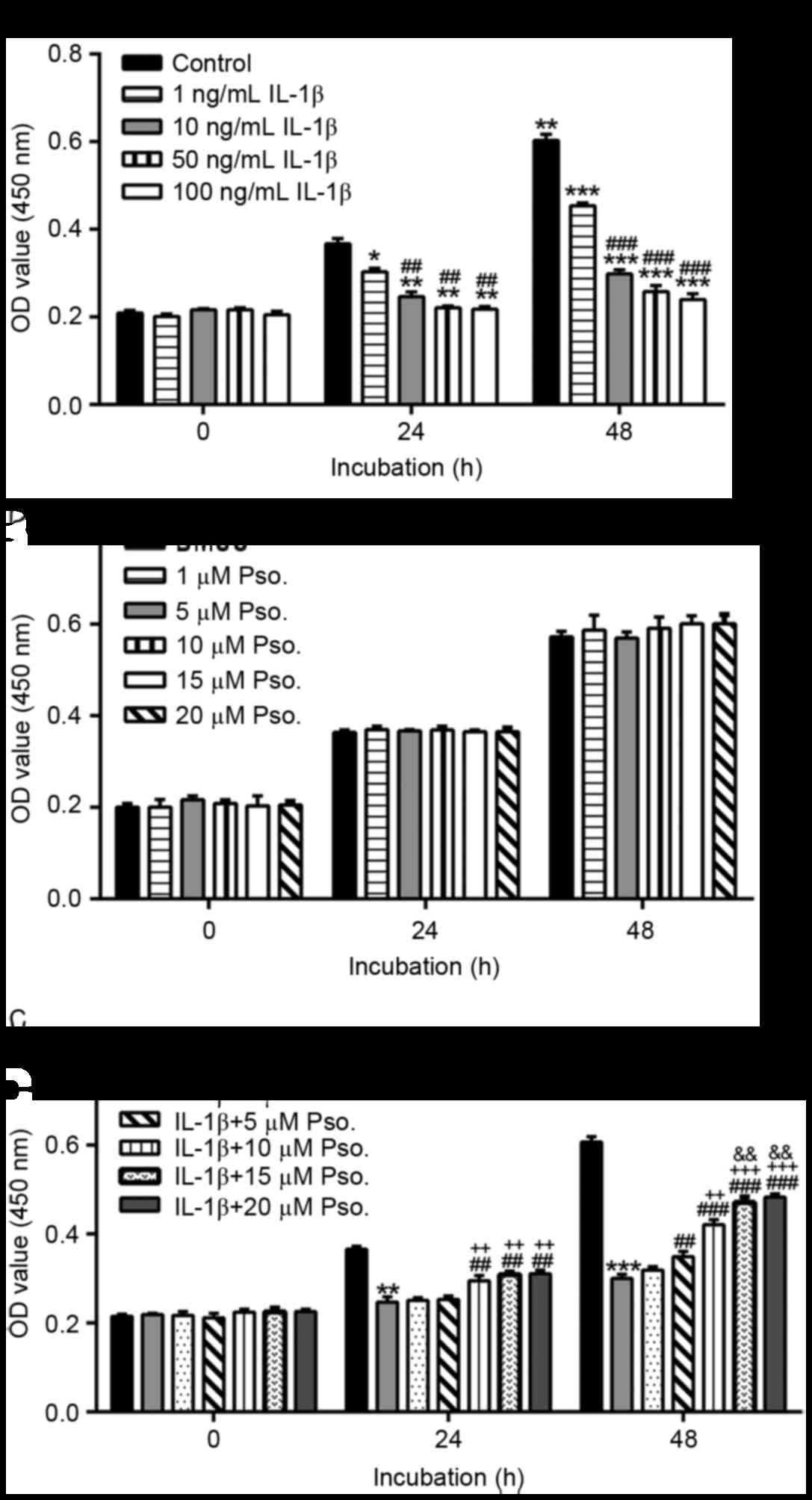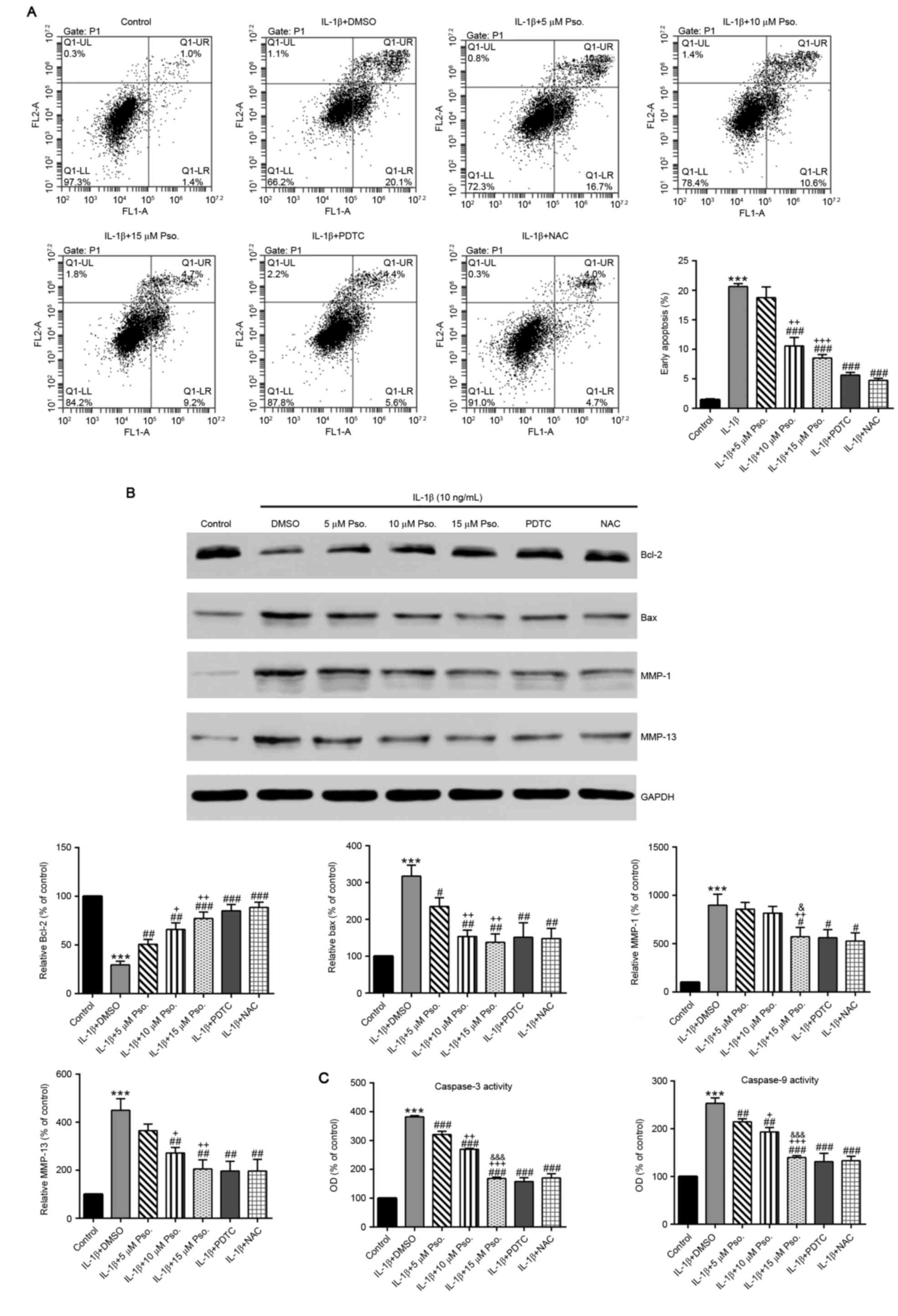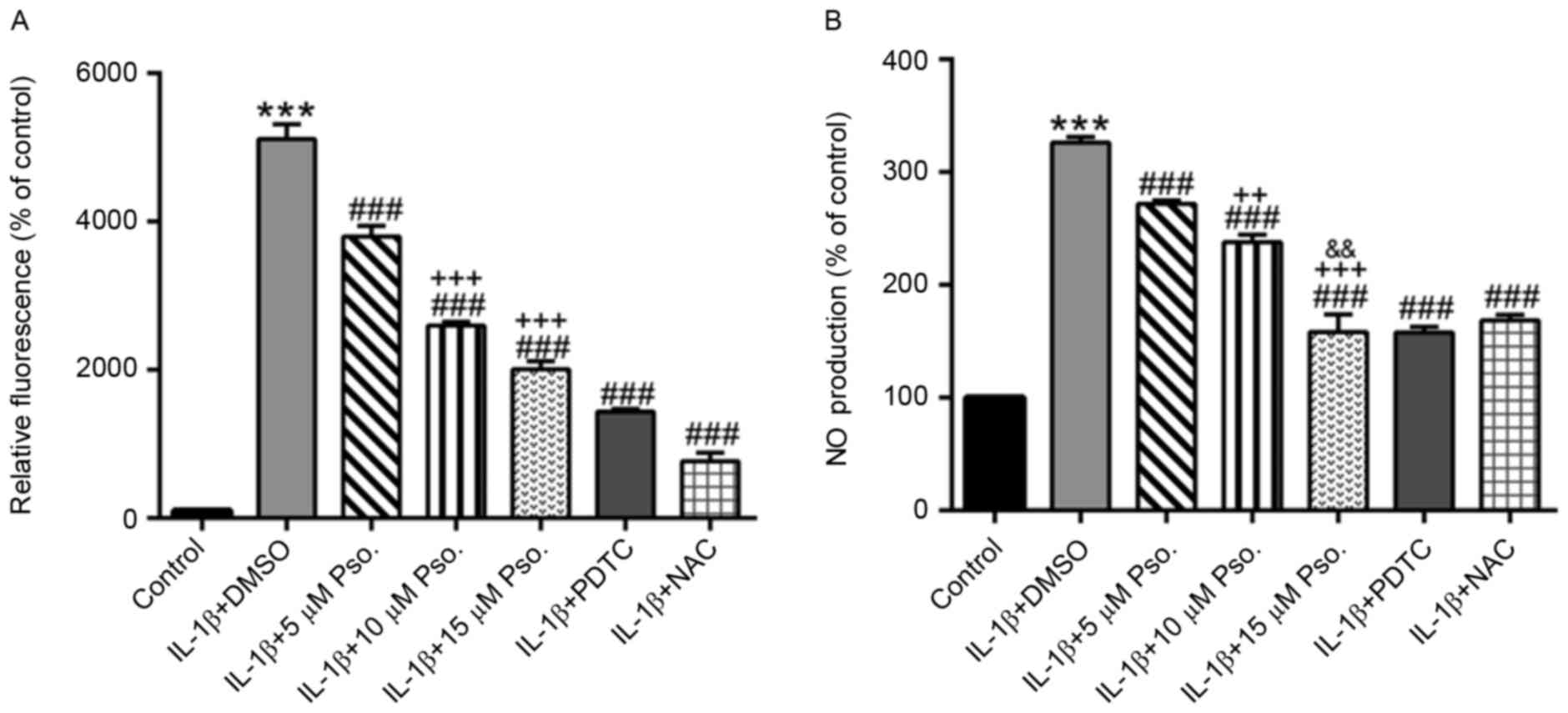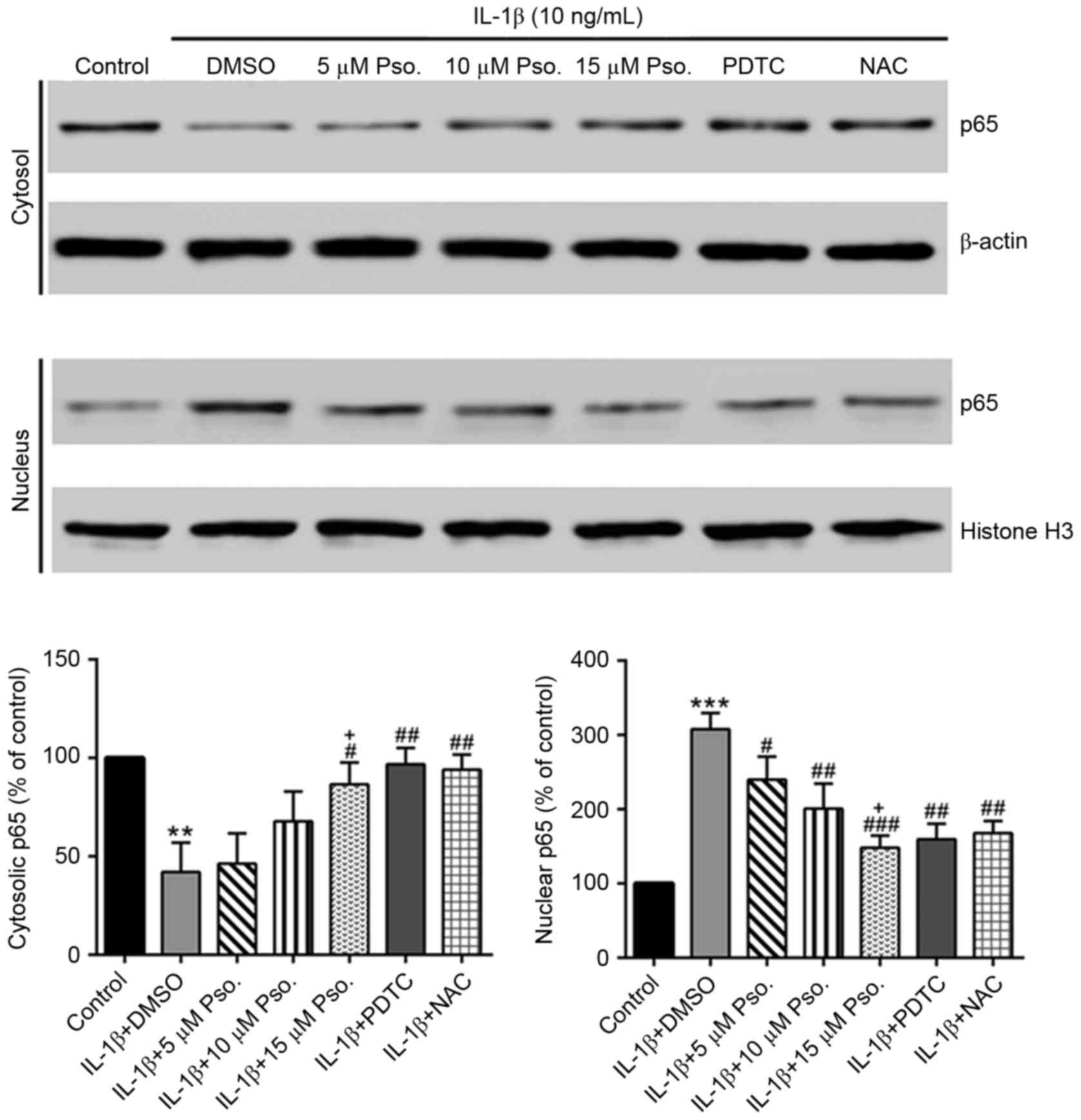Protective effects of psoralidin on IL‑1β‑induced chondrocyte apoptosis
- Authors:
- Published online on: December 11, 2017 https://doi.org/10.3892/mmr.2017.8248
- Pages: 3418-3424
Abstract
Introduction
Osteoarthritis represents the most common form of chronic joint disorder worldwide, the risk of which is significantly increased with age (1). Currently, commonly prescribed osteoarthritis medications include nonsteroidal anti-inflammatory drugs, analgesic drugs, and joint injection with glucocorticoids and visco-supplementation. However, these medications cannot halt the progression of the disease or reverse any damage caused by osteoarthritis. Surgical intervention is recommended for those patients with symptoms that persist after the appropriate use of nonsurgical treatment (2).
Osteoarthritis is characterized by progressive degradation of the extracellular cartilage matrix (ECM) and loss of chondrocytes (1,3). During the progression of osteoarthritis, the production of reactive oxygen species (ROS) (4) and the apoptosis of chondrocytes (5,6) is gradually increased. Previous evidence has suggested that the proinflammatory cytokine interleukin (IL)-1β serves an important role in the development of osteoarthritis. IL-1β levels are elevated in the synovial fluid, synovial membrane, subchondral bone and cartilage of patients with osteoarthritis (7). IL-1β induces the expression of matrix metalloproteinases (MMPs) in cultured chondrocytes, which leads to ECM degradation, abnormal bone metabolism and inflammatory disease (8–10). In addition, it has previously been reported that IL-1β can induce in vitro release of nitric oxide (NO), DNA damage (11), ROS production and mitochondrial damage in chondrocytes (12), thus leading to chondrocyte apoptosis. These processes may require the activation of nuclear factor (NF)-κB and mitogen-activated protein kinase pathways (13–16).
Psoralidin is one of the active ingredients isolated from the seeds of Psoralea corylifolia, which is extensively used in Asian and African traditional medicines and exerts therapeutic effects on cardiovascular and inflammatory diseases (17,18). In addition, psoralidin possesses osteoblast proliferation-stimulating (19), antibacterial (20) and antitumor activities (21–23). Nevertheless, no data is currently available regarding whether psoralidin can affect chondrocyte apoptosis. The present study aimed to investigate the effects of psoralidin on IL-1β-induced apoptosis of cultured rat chondrocytes and explored the possible mechanisms.
Materials and methods
Collection, isolation, and culture of rat chondrocytes
The present study was approved by the ethics committee of Tongji Hospital (Shanghai, China). Sprague-Dawley (SD) rats (n=6; age, 6 weeks; weight, 150–180 g) were purchased from Shanghai Experimental Animal Center (Shanghai, China). The rats were maintained at a controlled temperature (24±1°C) and controlled relative humidity (20–30%), under a 12-h light/dark cycle with free access to food and water. Following two days of acclimatization, the rats were sacrificed and the articular cartilage was collected and minced into small pieces before being digested with 0.4% type II collagenase solution (Sigma-Aldrich; Merck KGaA, Darmstadt, Germany) at 37°C for 5 h. Subsequently, the digested cartilage was passed through a 70-µm cell strainer to remove undigested tissues, and the chondrocytes were collected by centrifugation at 50 × g for 5 min. The cells were then cultured in Dulbecco's modified Eagle's medium (DMEM; Hyclone; GE Healthcare Life Sciences, Logan, UT, USA) supplemented with 10% fetal bovine serum (Gibco; Thermo Fisher Scientific, Inc., Waltham, MA, USA) at 37°C in an atmosphere containing 5% CO2.
Experimental grouping
To establish the appropriate dose of IL-1β, the cells were divided into five groups and treated with the following concentrations of IL-1β (Sigma-Aldrich; Merck KGaA): 0, 1, 10, 50 or 100 ng/ml. Subsequently, a Cell Counting Kit (CCK)-8 assay was performed after 0, 24 and 48 h to detect cell proliferation.
To investigate the effects of psoralidin on chondrocyte proliferation, cells were incubated with various doses of psoralidin (1, 5, 10, 15 or 20 µM; Shanghai YuanYe Biotechnology Co., Ltd., Shanghai, China) or vehicle [dimethyl sulfoxide (DMSO)]. Subsequently, cell proliferation was detected after 0, 24 and 48 h. To investigate the protective effects of psoralidin on IL-1β-induced cytotoxicity, cells were incubated with 10 ng/m IL-1β and various doses of psoralidin (1, 5, 10, 15 or 20 µM) or DMSO. Cells in the control group were cultured with vehicle only (DMSO). Cell proliferation was detected after 0, 24 and 48 h of incubation.
For all other experiments, the cells were divided into the following seven groups: Group 1 (control group), in which cells were cultured with vehicle (DMSO); group 2, in which cells were cultured with 10 ng/ml IL-1β and DMSO for 24 h; group 3, in which cells were cultured with 10 ng/ml IL-1β and 5 µM psoralidin for 24 h; group 4, in which cells were cultured with 10 ng/ml IL-1β and 10 µM psoralidin for 24 h; group 5, in which cells were cultured with 10 ng/ml IL-1β and 15 µM psoralidin for 24 h; group 6, in which cells were cultured with 30 µM pyrriolidine-dithiocarbamate (PDTC, NF-κB inhibitor; Sigma-Aldrich; Merck KGaA) and 10 ng/ml IL-1β for 24 h; and group 7, in which cells were cultured with 10 ng/ml IL-1β and 500 µM N-acetylcysteine (NAC; Sigma-Aldrich; Merck KGaA) for 24 h.
Cell proliferation assay
The chondrocytes were plated in 96-well plates (2×103 cells/well) and were cultured at 37°C for 12 h in serum-free DMEM. Following the appropriate treatment, cells were incubated with CCK-8 (Beyotime Institute of Biotechnology, Shanghai, China) at 37°C for 1 h. Optical density of each well was measured at a wavelength of 450 nm using a microplate reader (Bio-Rad Laboratories, Inc., Hercules, CA, USA).
Cell apoptosis assay
Apoptotic analysis was performed using an Annexin V-FITC flow cytometry apoptosis detection kit according to the manufacturer's protocol (Beyotime Institute of Biotechnology). After treatment, 1×106 cells were harvested and resuspended in binding buffer, after which the cells underwent Annexin V labeling for 15 min and propidium iodide (PI) labeling for 5 min in the dark at 4°C. The samples were analyzed using a flow cytometer (BD Biosciences, San Jose, CA, USA) with FlowJo analysis software version 7.6.5 (FlowJo LLC, Ashland, OR, USA) The percentage of Annexin V+/PI− cells was used to quantify the proportion of early apoptotic cells.
Protein extraction and western blotting
Total protein was extracted from the treated cells using radioimmunoprecipitation assay buffer with freshly added 0.01% protease inhibitor cocktail (Beijing Solarbio Science & Technology Co., Ltd., Beijing, China). Nuclear and cytosolic proteins were extracted using NE-PER™ Nuclear and Cytoplasmic Extraction Reagents (Thermo Fisher Scientific, Inc.). A total of 30 µg of proteins were separated by 10 or 15% SDS-PAGE and were then transferred onto nitrocellulose membranes (EMD Millipore, Bedford, MA, USA). Protein expression levels were analyzed by western blotting. The membranes were blocked with 5% skimmed milk at room temperature for 1 h, incubated with the appropriate primary antibodies overnight at 4°C. Antibodies against B-cell lymphoma 2 (Bcl-2; sc-492; 1:200) and Bcl-2-associated X protein (Bax; sc-493; 1:200) were purchased from Santa Cruz Biotechnology, Inc. (Dallas, TX, USA). The MMP-13 antibody (ab39012; 1:3,000) was obtained from Abcam (Cambridge, UK), and the MMP-1 antibody (10371–2-AP; 1:1,000) was purchased from ProteinTech Group, Inc. (Chicago, IL, USA). Antibodies against GAPDH (5174; 1:2,000), NF-κB p65 (8242; 1:1,000), β-actin (4970; 1:1,000) and histone H3 (4499S; 1:2,000) were purchased from Cell Signaling Technology, Inc. (Danvers, MA, USA). The membranes were then incubated with secondary antibodies (A0208 and A0216; 1:1,000; Beyotime Institute of Biotechnology) at room temperature for 1 h. Densitometric analysis was performed with ImageJ software version 1.41 (National Institutes of Health, Bethesda, MD, USA).
Caspase-3 and −9 activity assay
Caspase-3 and −9 activity was measured using the Caspase colorimetric assay kit (Nanjing Keygen Biotech Co., Ltd., Nanjing, China) according to the manufacturer's protocol. Briefly, cells were collected and lysed using the lysis buffer provided. Absorbance values at 400 nm were determined using a microplate reader (Bio-Rad Laboratories, Inc.). The control group values were set at 100%, and results are expressed as a percentage of the control.
Measurement of intracellular ROS levels
Following treatment, the levels of intracellular ROS were measured by flow cytometry following incubation with dichlorofluorescein diacetate (Beyotime Institute of Biotechnology) for 20 min in the dark at 37°C. Results were expressed as a percentage of the control group fluorescence intensity.
NO production
NO concentration in the medium was measured according to the Griess reaction method. Briefly, 50 µl Griess reagent (Nanjing Jiancheng Bioengineering Institute, Nanjing, China) was mixed with 50 µl cultured medium from treated cells and was incubated in the dark for 10 min. The absorbance was measured at 550 nm using a microplate reader (Bio-Rad Laboratories, Inc.). The control group values were set at 100%, and results are presented as a percentage of the control.
Statistical analysis
Data were analyzed using GraphPad Prism statistical software version 6.0 (GraphPad Software, Inc., La Jolla, CA, USA). Data are presented as the mean ± standard deviation of three independent experiments. One-way analysis of variance followed by Dunnett's multiple comparisons test was used for statistical analysis. P<0.05 was considered to indicate a statistically significant difference.
Results
Effects of psoralidin on IL-1β-induced damage
To establish the appropriate dose of IL-1β, isolated primary chondrocytes were incubated with 0, 1, 10, 50 or 100 ng/ml IL-1β. A total of 24 and 48 h after treatment, cell proliferation was significantly decreased by IL-1β (Fig. 1A). The results indicated that 10 ng/ml IL-1β had comparable effects to 50 and 100 ng/ml IL-1β; therefore, 10 ng/ml IL-1β was used in the subsequent experiments.
The present study also investigated the effects of psoralidin on chondrocyte proliferation (Fig. 1B). Cell proliferation was similar in cells treated with psoralidin (1, 5, 10, 15 or 20 µM) and cells treated with vehicle (DMSO), thus suggesting that psoralidin exerted no cytotoxic effects on chondrocytes. In addition, the protective effects of psoralidin on IL-1β-induced cytotoxicity were analyzed. Cells were treated with 10 ng/ml IL-1β and various concentrations of psoralidin (1, 5, 10, 15 or 20 µM) or vehicle (DMSO). Cell proliferation was significantly decreased by IL-1β (Fig. 1C) at 24 and 48 h post-treatment. A total of 24 h after treatment, IL-1β-induced cell damage was significantly reduced by the addition of psoralidin at doses of 10, 15 and 20 µM (P<0.01). Treatment with 5, 10 or 15 µM psoralidin for 48 h exerted protective effects in a dose-dependent manner; however, there was no significant difference between the 15 and 20 µM psoralidin groups. Therefore, 5, 10 and 15 µM psoralidin were used in subsequent experiments.
Effects of psoralidin on IL-1β-induced chondrocyte apoptosis
To determine the potential effects of psoralidin on IL-1β-induced chondrocyte apoptosis, chondrocytes were incubated with various concentrations of psoralidin (0, 5, 10 or 15 µM) and IL-1β (10 ng/ml) for 24 h. NAC is known to prevent chondrocyte apoptosis and cartilage destruction (24); therefore, additional treatment with NAC (500 µM) was used as a positive control. The ratio of apoptotic cells was assessed by Annexin V/PI labeling. As presented in Fig. 2A, the average apoptotic ratio of chondrocytes exposed to IL-1β was 20.6% compared with the untreated control chondrocytes (1.5%; P<0.001), whereas the addition of the NF-κB inhibitor PDTC or NAC markedly decreased the apoptotic ratio (P<0.001). In addition, treatment with psoralidin resulted in a dose-dependent reduction in the ratio of apoptotic cells.
Effects of psoralidin on the expression of Bcl-2, Bax and MMP-1/13, and caspase-3/9 activation of chondrocytes exposed to IL-1β
To investigate whether the mitochondrial apoptotic pathway was affected, the protein expression levels of Bcl-2 and Bax were evaluated by western blotting. As shown in Fig. 2B, compared with in the control cells, IL-1β treatment led to a significant decrease in the expression of the anti-apoptotic protein Bcl-2, and a significant increase in the proapoptotic protein Bax (P<0.001). Conversely, when psoralidin, PDTC or NAC were added, Bcl-2 expression was significantly increased compared with in the IL-1β group, whereas Bax expression was significantly reduced (P<0.01).
Alterations in caspase-3 and −9 activity were also detected. As shown in Fig. 2C, addition of psoralidin, PDTC or NAC significantly inhibited IL-1β-mediated caspase-3 and −9 activation (P<0.01). Of the three doses of psoralidin tested, 15 µM psoralidin had the most marked effects.
IL-1β is able induce the expression of collagenases (MMP-1 and −13), which degrade native collagen fibers and expedite chondrocyte apoptosis (9). Compared with in the control cells, IL-1β treatment induced a significant increase in the expression levels of MMP-1 and −13. (P<0.001), which was abrogated by the addition of 15 µM psoralidin, PDTC or NAC (P<0.05).
Effects of psoralidin on IL-1β-induced ROS and NO production
The present study also analyzed intracellular ROS and NO production (Fig. 3). IL-1β (10 ng/ml) was able to significantly induce ROS and NO production (P<0.001), which was markedly decreased by the addition of psoralidin, PDTC or NAC (P<0.001). Psoralidin exerted its effects in a dose-dependent manner.
Effects of psoralidin on IL-1β-induced NF-κB nuclear translocation
IL-1β is known to induce NF-κB nuclear translocation in chondrocytes (13). As presented in Fig. 4, IL-1β was able to significantly induce nuclear translocation of NF-κB (P<0.01), which was partially abrogated by the addition of psoralidin, PDTC or NAC (P<0.05).
Discussion
Psoralidin has been reported to possess osteoblast proliferation-stimulating (19), antibacterial (20) and antitumor activities (21–23). However, the effects of psoralidin on osteoarthritis have yet to be reported. The results of the present study indicated that psoralidin protected rat chondrocytes from IL-1β-induced apoptosis. In addition, it promoted Bcl-2 expression, reduced Bax expression, and decreased activation of caspase-3 and −9. Psoralidin also inhibited the expression of MMP-1 and −13, the production of ROS, the release of NO, and NF-κB nuclear translocation.
IL-1β can induce chondrocyte apoptosis; therefore, it may be implicated in osteoarthritis pathophysiology (25). Consistent with the results of previous studies (11,12), IL-1β treatment significantly inhibited the proliferation and induced apoptosis of rat chondrocytes, whereas the addition of psoralidin (10 or 15 µM) markedly suppressed IL-1β-mediated apoptosis. Previous studies in various cancer cell lines, including gastric, prostate, breast and colon cancers, suggested that psoralidin exerts cytotoxic and proapoptotic activities (23,26–29). These inconsistent results may be due to the different cell types and treatments used. Bcl-2 family proteins are able to alter permeability of the mitochondrial membrane and can finally activate caspase-9, −3 and −7 to initiate apoptosis (30). The present study demonstrated that psoralidin alleviated the IL-1β-induced increase in the Bax to Bcl-2 ratio, as well as the activity of caspase-3 and −9. The results also suggested that psoralidin affected IL-1β-induced apoptosis via the mitochondrial apoptosis pathway. In addition, IL-1β can induce the release of NO (11) and the production of ROS (12), which eventually leads to chondrocyte apoptosis. In the present study, psoralidin was able to partially reverse the effects of IL-1β on NO release and ROS production, thus affecting cell apoptosis.
In addition to chondrocyte apoptosis, cartilage destruction is a main characteristic of osteoarthritis. In line with previous observations that IL-1β can induce MMP expression (8–10), the present study indicated that the expression of MMP-1 and −13, which are two key regulators of cartilage destruction, was induced by IL-1β. Psoralidin partially abolished such effects, indicating the protective role of psoralidin in cartilage destruction.
IL-1β can induce NF-κB activation in chondrocytes (13). The present study also analyzed the role of NF-κB in IL-1β-induced chondrocyte apoptosis. IL-1β-induced NF-κB nuclear translocation was effectively inhibited by PDTC. In addition, PDTC partially blocked IL-1β-induced apoptosis, NO release, ROS production and MMP expression in chondrocytes. These results suggested that IL-1β induced proapoptotic effects via an NF-κB-dependent pathway. In addition, a high dose of psoralidin (15 µM) had comparable effects to PDTC, and therefore may be considered a drug candidate for the treatment of osteoarthritis. Further in vivo animal experiments are required to assess the therapeutic potential of psoralidin.
In conclusion, the findings of the present study demonstrated that psoralidin may inhibit IL-1β-induced chondrocyte apoptosis, NO production, ROS release, and MMP-1 and −13 expression, and may suppress IL-1β-activated NF-κB nuclear translocation. Collectively, these data indicated the potential therapeutic role of psoralidin in osteoarthritis treatment.
References
|
Loeser RF: Aging and osteoarthritis. Curr Opin Rheumatol. 23:492–496. 2011. View Article : Google Scholar : PubMed/NCBI | |
|
Rönn K, Reischl N, Gautier E and Jacobi M: Current surgical treatment of knee osteoarthritis. Arthritis. 2011:4548732011. View Article : Google Scholar : PubMed/NCBI | |
|
Thomas CM, Fuller CJ, Whittles CE and Sharif M: Chondrocyte death by apoptosis is associated with cartilage matrix degradation. Osteoarthritis Cartilage. 15:27–34. 2007. View Article : Google Scholar : PubMed/NCBI | |
|
Li D, Xie G and Wang W: Reactive oxygen species: The 2-edged sword of osteoarthritis. Am J Med Sci. 344:486–490. 2012. View Article : Google Scholar : PubMed/NCBI | |
|
Sharif M, Whitehouse A, Sharman P, Perry M and Adams M: Increased apoptosis in human osteoarthritic cartilage corresponds to reduced cell density and expression of caspase-3. Arthritis Rheum. 50:507–515. 2004. View Article : Google Scholar : PubMed/NCBI | |
|
Matsuo M, Nishida K, Yoshida A, Murakami T and Inoue H: Expression of caspase-3 and −9 relevant to cartilage destruction and chondrocyte apoptosis in human osteoarthritic cartilage. Acta Med Okayama. 55:333–340. 2001.PubMed/NCBI | |
|
Koopman WJ and Moreland LW: Arthritis and allied conditions: a textbook of rheumatology. Lippincott Williams Wilkins; Philadelphia, PA: 2001 | |
|
Koskinen A, Vuolteenaho K, Nieminen R, Moilanen T and Moilanen E: Leptin enhances MMP-1, MMP-3 and MMP-13 production in human osteoarthritic cartilage and correlates with MMP-1 and MMP-3 in synovial fluid from OA patients. Clin Exp Rheumatol. 29:57–64. 2011.PubMed/NCBI | |
|
Aida Y, Maeno M, Suzuki N, Shiratsuchi H, Motohashi M and Matsumura H: The effect of IL-1beta on the expression of matrix metalloproteinases and tissue inhibitors of matrix metalloproteinases in human chondrocytes. Life Sci. 77:3210–3221. 2005. View Article : Google Scholar : PubMed/NCBI | |
|
Elshaier AM, Hakimiyan AA, Rappoport L, Rueger DC and Chubinskaya S: Effect of interleukin-1beta on osteogenic protein 1-induced signaling in adult human articular chondrocytes. Arthritis Rheum. 60:143–154. 2009. View Article : Google Scholar : PubMed/NCBI | |
|
Zhou PH, Liu SQ and Peng H: The effect of hyaluronic acid on IL-1beta-induced chondrocyte apoptosis in a rat model of osteoarthritis. J Orthop Res. 26:1643–1648. 2008. View Article : Google Scholar : PubMed/NCBI | |
|
Kim J, Xu M, Xo R, Mates A, Wilson GL, Pearsall AW IV and Grishko V: Mitochondrial DNA damage is involved in apoptosis caused by pro-inflammatory cytokines in human OA chondrocytes. Osteoarthritis Cartilage. 18:424–432. 2010. View Article : Google Scholar : PubMed/NCBI | |
|
Lee HS, Lee CH, Tsai HC and Salter DM: Inhibition of cyclooxygenase 2 expression by diallyl sulfide on joint inflammation induced by urate crystal and IL-1beta. Osteoarthritis Cartilage. 17:91–99. 2009. View Article : Google Scholar : PubMed/NCBI | |
|
Wuertz K, Vo N, Kletsas D and Boos N: Inflammatory and catabolic signalling in intervertebral discs: The roles of NF-κB and MAP kinases. Eur Cell Mater. 23:103–120. 2012.PubMed/NCBI | |
|
Radons J, Bosserhoff AK, Grässel S, Falk W and Schubert TE: p38MAPK mediates IL-1-induced down-regulation of aggrecan gene expression in human chondrocytes. Int J Mol Med. 17:661–668. 2006.PubMed/NCBI | |
|
Sondergaard BC, Schultz N, Madsen SH, Bay-Jensen AC and Karsdal MA: MAPKs are essential upstream signaling pathways in proteolytic degradation-divergence in pathways leading to aggrecanase and MMP mediated articular cartilage degradation. Osteoarthritis Cartilage. 18:279–288. 2010. View Article : Google Scholar : PubMed/NCBI | |
|
Chopra B, Dhingra AK and Dhar KL: Psoralea corylifolia L. (Buguchi)-Folklore to modern evidence: Review. Fitoterapia. 90:44–56. 2013. View Article : Google Scholar : PubMed/NCBI | |
|
Zhao L, Huang C, Shan Z, Xiang B and Mei L: Fingerprint analysis of Psoralea corylifolia L. by HPLC and LC-MS. J Chromatogr B Analyt Technol Biomed Life Sci. 821:67–74. 2005. View Article : Google Scholar : PubMed/NCBI | |
|
Wang D, Li F and Jiang Z: Osteoblastic proliferation stimulating activity of Psoralea corylifolia extracts and two of its flavonoids. Planta Med. 67:748–749. 2001. View Article : Google Scholar : PubMed/NCBI | |
|
Khatune NA, Islam ME, Haque ME, Khondkar P and Rahman MM: Antibacterial compounds from the seeds of Psoralea corylifolia. Fitoterapia. 75:228–230. 2004. View Article : Google Scholar : PubMed/NCBI | |
|
Pahari P and Rohr J: Total synthesis of psoralidin, an anticancer natural product. J Org Chem. 74:2750–2754. 2009. View Article : Google Scholar : PubMed/NCBI | |
|
Yu B, Wang AH, Zhou K, Chai LJ and Liu L: The molecular pathway of psoralidin-induced apoptosis in HepG2 cell line. Chin J Integr Med. Mar 29–2016.(Epub ahead of print). View Article : Google Scholar | |
|
Srinivasan S, Kumar R, Koduru S, Chandramouli A and Damodaran C: Inhibiting TNF-mediated signaling: A novel therapeutic paradigm for androgen independent prostate cancer. Apoptosis. 15:153–161. 2010. View Article : Google Scholar : PubMed/NCBI | |
|
Nakagawa S, Arai Y, Mazda O, Kishida T, Takahashi KA, Sakao K, Saito M, Honjo K, Imanishi J and Kubo T: N-acetylcysteine prevents nitric oxide-induced chondrocyte apoptosis and cartilage degeneration in an experimental model of osteoarthritis. J Orthop Res. 28:156–163. 2010.PubMed/NCBI | |
|
Kapoor M, Martel-Pelletier J, Lajeunesse D, Pelletier JP and Fahmi H: Role of proinflammatory cytokines in the pathophysiology of osteoarthritis. Nat Rev Rheumatol. 7:33–42. 2011. View Article : Google Scholar : PubMed/NCBI | |
|
Yang YM, Hyun JW, Sung MS, Chung HS, Kim BK, Paik WH, Kang SS and Park JG: The cytotoxicity of psoralidin from Psoralea corylifolia. Planta Med. 62:353–354. 1996. View Article : Google Scholar : PubMed/NCBI | |
|
Mar W, Je KH and Seo EK: Cytotoxic constituents of Psoralea corylifolia. Arch Pharm Res. 24:211–213. 2001. View Article : Google Scholar : PubMed/NCBI | |
|
Szliszka E, Czuba ZP, Sędek Ł, Paradysz A and Król W: Enhanced TRAIL-mediated apoptosis in prostate cancer cells by the bioactive compounds neobavaisoflavone and psoralidin isolated from Psoralea corylifolia. Pharmacol Rep. 63:139–148. 2011. View Article : Google Scholar : PubMed/NCBI | |
|
Bronikowska J, Szliszka E, Jaworska D, Czuba ZP and Krol W: The coumarin psoralidin enhances anticancer effect of tumor necrosis factor-related apoptosis-inducing ligand (TRAIL). Molecules. 17:6449–6464. 2012. View Article : Google Scholar : PubMed/NCBI | |
|
Gross A, Mcdonnell JM and Korsmeyer SJ: BCL-2 family members and the mitochondria in apoptosis. Genes Dev. 13:1899–1911. 1999. View Article : Google Scholar : PubMed/NCBI |













